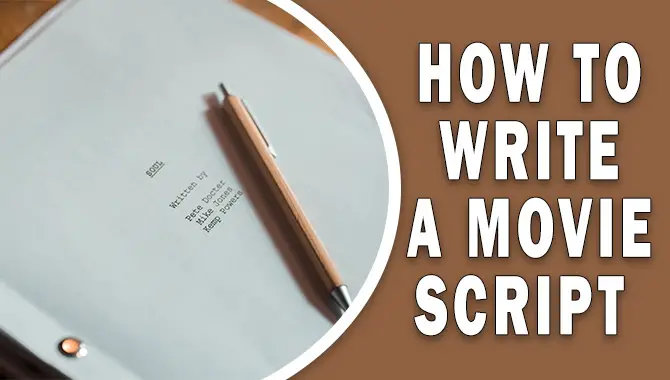Start by reading a lot of scripts. There are many resources available online, as well as in libraries. You can also find screenplays of movies that you’ve seen and liked. Notice the differences in how each story is told.
Create an outline for your story. This will be the framework on which you build your screenplay.
Begin with the basics of scene structure. Every scene should have a purpose and advance the story.
Pay attention to the format of your script. This is important as it will be the template for how your story will be told on screen.
Keep your dialogue short, sharp, and to the point.
Remember that a screenplay is a visual medium. Use action and description to set the scene and create an immersive experience for the reader.
Finally, don’t be afraid to revise and rewrite your script. The first draft is rarely the best. Be prepared to work hard to make your screenplay the best it can be.

How Do You Format A Movie Script?
How do you format a movie script?
You can format a movie script in a few different ways, but the most common way is to use the industry standard format. This format is designed to make it easy for industry professionals to read and understand your script.
Here is a step-by-step guide to formatting a movie script using the industry standard format:
1. Use 12-point Courier font.
2. Use 1-inch margins on all sides.
3. Use double spacing.
4. Indent each new scene by 2.5 inches.
5. Use parenthetical descriptions to describe characters’ actions and emotions.
6. Use uppercase letters for character names when they are speaking.
7. Use transitions to indicate scene changes.
Here is an example of how this format would look in a script:
FADE IN:
EXT. HOUSE – DAY
(The camera pans across a beautiful house. We can see the sun shining and the flowers blooming. There is a family of four playing in the yard.)
MOTHER
(to the father)
Honey, I think it’s time to start grilling the burgers.
FATHER
(to the mother)
Okay, I’ll do it.
(He starts to walk towards the grill, but then he stops and turns back to the mother.)
FATHER
Oh, and by the way, I love you.
MOTHER
I love you too.
(He kisses her and then walks off-screen. The camera focuses on the mother as she watches him go. We can see the love in her eyes.)
FADE TO:
EXT. PARK – DAY
(The camera pans across a park. We see a group of children playing on the playground. One of the children, a little girl, is sitting on the swings by herself.)
GIRL
(sighing)
I wish I had someone to play with.
(Suddenly, a boy walks up to her.)
BOY
Hi, I’m Tim.
Do you want to be my friend?
GIRL
(smiling)
Yes, I’d like that.
(They walk off-screen together, hand in hand.)
THE END
How Do You Come Up With Ideas For A Movie Script?

How Do You Come Up With Ideas for a Movie Script?
It is a question that plagues many aspiring writers. How do you take an idea and turn it into a full-fledged script?
Here are a few tips to get you started:
1. Know Your Genre
Before you start writing, it’s important to know.
Knowing your genre will help you develop ideas that align with what you’re passionate about.
2. Brainstorm
Once you know what genre you’re interested in, it’s time to start brainstorming. This can be done alone or with a group of people. If you’re struggling to develop ideas independently, talking to others can help jumpstart the process. Ask friends and family what kind of movies they like to watch. See if they have any ideas for a script.
3. Do Your Research
If you’re unsure what kind of story you want to tell, research can be helpful. Read books and watch movies in the genre you’re interested in. This will help you get a feel for what’s been done before and what’s popular with audiences.
4. Write a treatment
Once you have a general idea for your script, it’s time to start writing a treatment. This summary of the story includes the plot, characters, and setting. This will be used as a guide when you start writing the actual script.
5. Don’t give up
Writing a script can be daunting, but it’s important to persevere. If you get stuck, take a break and return to it later. The most important thing is to keep writing and to finish what you start.
If you follow these tips, you’ll be well on your way to writing a great script. Just remember to be creative and have fun with it.
How Do You Develop Characters For A Movie Script?
Have you ever wondered
How Do Screenwriters Create Interesting and Compelling Characters?
Characters are the heart of any good story, so getting them right is important. Here are a few tips on how to develop characters for your next movie script:
1. Start With the Basics
What is your character’s name, age, gender, occupation, and so on? This will help you to understand your character’s basic identity.
2. Give Your Character a Goal
This will help to create conflict and make your character more interesting.
3. Make Your Character Flawed
No one is perfect, and neither should your characters be. Give them some flaws and weaknesses to make them more relatable and human.
4. Use Dialogue to Reveal Character
Dialogue can be a great tool for revealing character.
5. Give Your Character a Backstory
A backstory can help to make your character more three-dimensional.
6. Use Physicality to Reveal Character
Physicality can be a great way to show character without relying on dialogue.
7. Put Your Character in Conflict
Conflict will help to make your character more interesting and compelling.
8. Let Your Character Grow
As the story progresses, allow your character to change and grow. This will make them more believable and relatable.
9. Have Someone Else Read Your Script
It’s always helpful to get another set of eyes on your work. Have someone else read your script and give you feedback on your characters.
10. Keep Revising
Characters are never perfect on the first try.Keep revising and tweaking until you’re happy with them.
Developing compelling and interesting characters is an essential part of screenwriting. By following these tips, you can ensure your characters are well-rounded and engaging.
How Do You Structure A Movie Script?
You may wonder how to structure a movie script if you’re a budding screenwriter. After all, knowing where to start with all the elements that go into a film cannot be easy.
Here’s a quick overview of how to structure a movie script:
1. The Inciting Incident
The first step in structuring a movie script is identifying the inciting incident. This event sets the story in motion and propels the protagonist toward the goal.
For example, in the movie Die Hard, the inciting incident is when terrorists take John McClane’s wife hostage.
2. The Conflict
The conflict is the central problem of the story. This is what the protagonist must overcome to achieve the goal.
In Die Hard, the conflict is McClane’s battle to rescue his wife and stop the terrorists.
3. The Climax
The climax is the most intense moment of the story when the protagonist confronts the conflict head-on. This is the moment when the outcome of the story is decided.
In Die Hard, the climax is the showdown between McClane and the terrorist leader.
4. The Resolution
The resolution is the conclusion of the story, in which the conflict is resolved, either positively or negatively.
In Die Hard, the resolution is positive, as McClane can rescue his wife and defeat the terrorists.
Remember that this is just a basic outline of structuring a movie script. There are many different ways to approach scriptwriting, and there is no one correct way. However, following this basic structure will give you a solid foundation to build your story.
Conclusion
A movie script is a document that contains the dialogue and other directions for a movie. It is also known as a screenplay. To write a movie script, you will need to come up with a story, develop characters, and write dialogue. You will also need to format your script in a specific way.
Hopefully, you are clear now on how to write a movie script. If you still have any questions, feel free to comment below.

I’m a writer and blogger who loves to talk about entertainment, culture, and relationships. I love to share my thoughts and insights on these topics, and I’m always looking for new ways to engage with my readers. I’m also a big fan of learning new things, so I’m always exploring new areas of interest.
